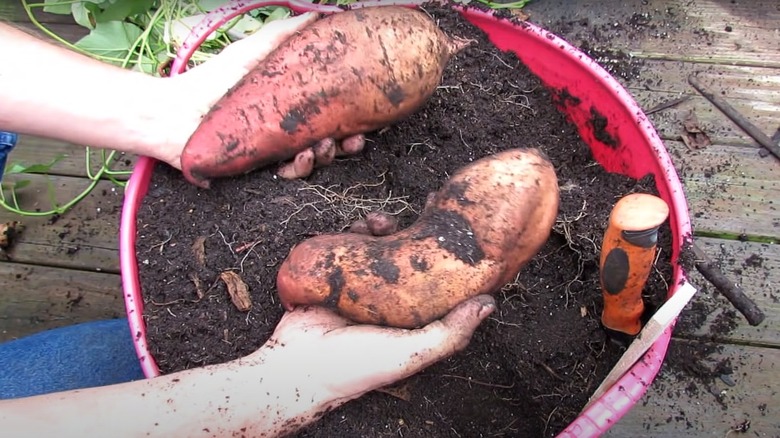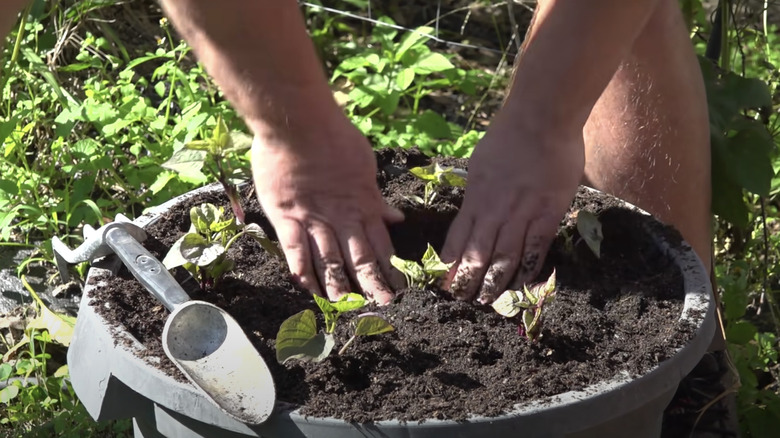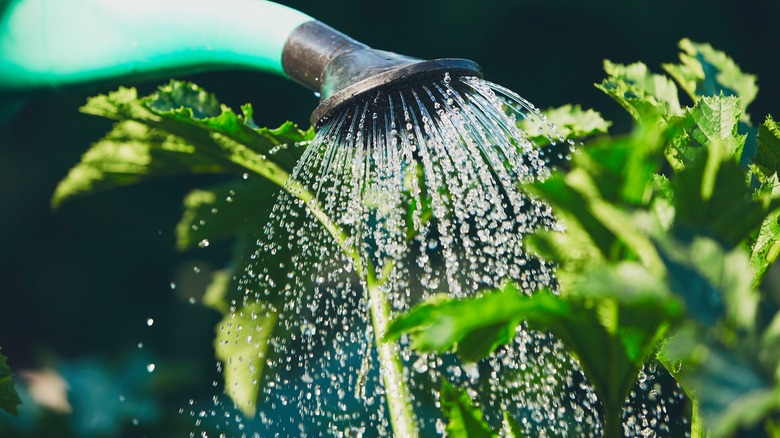How To Perfectly Grow Sweet Potatoes In Containers Like A Pro
Many folks who'd love to grow vegetables in their backyard but don't have the space for them won't try growing them. However, most vegetables don't need a vast area to grow properly. Many vegetables thrive in containers. For example, sweet potatoes can be grown in containers in your backyard. Sweet potatoes are a perfect addition to any meal; they offer multiple nutritional sources, such as potassium, fiber, and vitamins A, C, and B6. They're also effortless to grow since they have a long harvesting period, so you'll have sweet potatoes growing for months.
There are many sweet potato varieties, but it's vital to purchase ones that can handle being grown in containers. These sweet potatoes will grow in a bunch together instead of sporadically, making them perfect for smaller spaces. For anyone new to sweet potatoes, they are known for growing with long trailing vines, so purchasing a bush variety is essential for growing them in smaller spaces. Buying your varieties from an in-person or online garden center is also important so you can find the right ones. Grocery stores won't always tell you what sweet potato varieties they have, so avoid purchasing them there. Once you have the varieties you want to grow, it's time to start planting them.
How to grow sweet potatoes
Since you'll be growing your sweet potatoes in containers, choose a large sized container if you'd like to grow multiple of them. The best containers to consider are ones that hold 20 to 30 gallons, which will hold around four to six sweet potato slips. Fabric grow bags for your garden are also an excellent option. They allow proper aeration for the roots and have the best drainage system. Although plastic or wood containers work well as well. Just add a few holes to the bottom for the water to drain.
After you've chosen your desired container, you need the soil. Sweet potatoes always prefer moist soil, and they enjoy amended potting soil with compost and sand to allow airflow throughout the container. You can also add fertilizer to the amended soil or wait two weeks after watering to fertilize the soil. Fill your container with four inches of your soil, place in the sweet potato slips, and add another three inches of soil on top. Your container shouldn't be filled with soil at first since your potatoes need to start growing. Once their stems start to grow, you'll be able to add more soil. After you plant the slips, water the soil and allow it to drain correctly. Check the soil every day to ensure it stays moist, and water it when it's dry.
Caring for your sweet potatoes
To make growing your sweet potatoes easy, water them weekly with at least one inch of water. However, if you plant them in a grow bag, you might need to water them more frequently because the soil will dry faster. You don't want their soil to dry out. Place them in an area where they'll receive full sun for six to eight hours in warm or hot weather, so keeping their soil moist is crucial. Furthermore, fertilize them with phosphorus, nitrogen, and potassium every four to six weeks after the first round of fertilization so that they continue growing. Their last fertilization should be three weeks before harvest; sweet potatoes only need about three rounds of fertilization throughout their growing season.
Sweet potatoes don't require a lot of pruning, only when there are unhealthy leaves or the vines are growing too long. A few pests to look out for are cucumber bugs, sweet potato weevils, and flea beetles. Sweet potato weevils are the most common pest that can damage your sweet potatoes terribly. They're larger bugs that lay eggs on the sweet potato's roots and feed on its tuber. The slips can be infected before you buy them, so ensure you purchase them from a trustworthy garden center.


